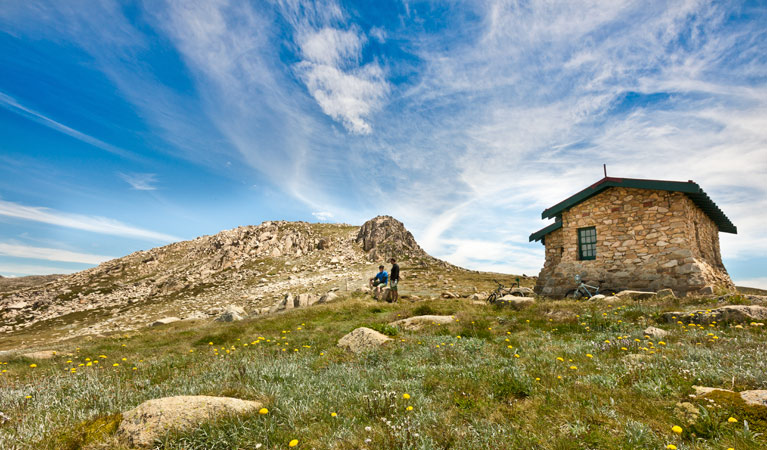Thredbo-Perisher area
Kosciuszko National Park
Overview
Thredbo-Perisher area is your gateway to Mount Kosciuszko. Find NSW's favourite ski resorts, top alpine hikes, mountain bike trails, and endless adventures in the Snowy Mountains.
Read more about Thredbo-Perisher area
In winter, ski or snowboard the slopes at Thredbo, Perisher or Charlotte Pass. Perisher is the largest ski resort in the Southern Hemisphere. Try cross country skiing or snowshoe the pristine trails amongst twisted snow gums.
As the snow melts you'll discover a walker's paradise. Tracks range from short riverside strolls and moderate day walks, to multi-day hikes. Conquer Mount Kosciuszko, Australia's highest mountain, on the Thredbo to Kosciuszko walk. You can also take the longer Summit trail or Main Range walk. Have your camera ready for mountain panoramas, dazzling summer wildflowers, and the famous Snowy River.
Thrill seekers can hit some of Australia's best mountain bike runs, including Thredbo Valley track. The scenery is also a stunning backdrop for festivals, summer fishing, or even a wedding at historic Bullocks Hut.
With year-round alpine activities you'll need several days to make the most of the Snowies. Why not pitch your tent at a riverside campground, or stay at Creel Lodge or Numbananga Lodge.
Local alerts
For the latest updates on fires, closures and other alerts in this area, see https://uat.nswparks.cloud/visit-a-park/parks/thredbo-perisher-area/local-alerts
Map

Map

Map
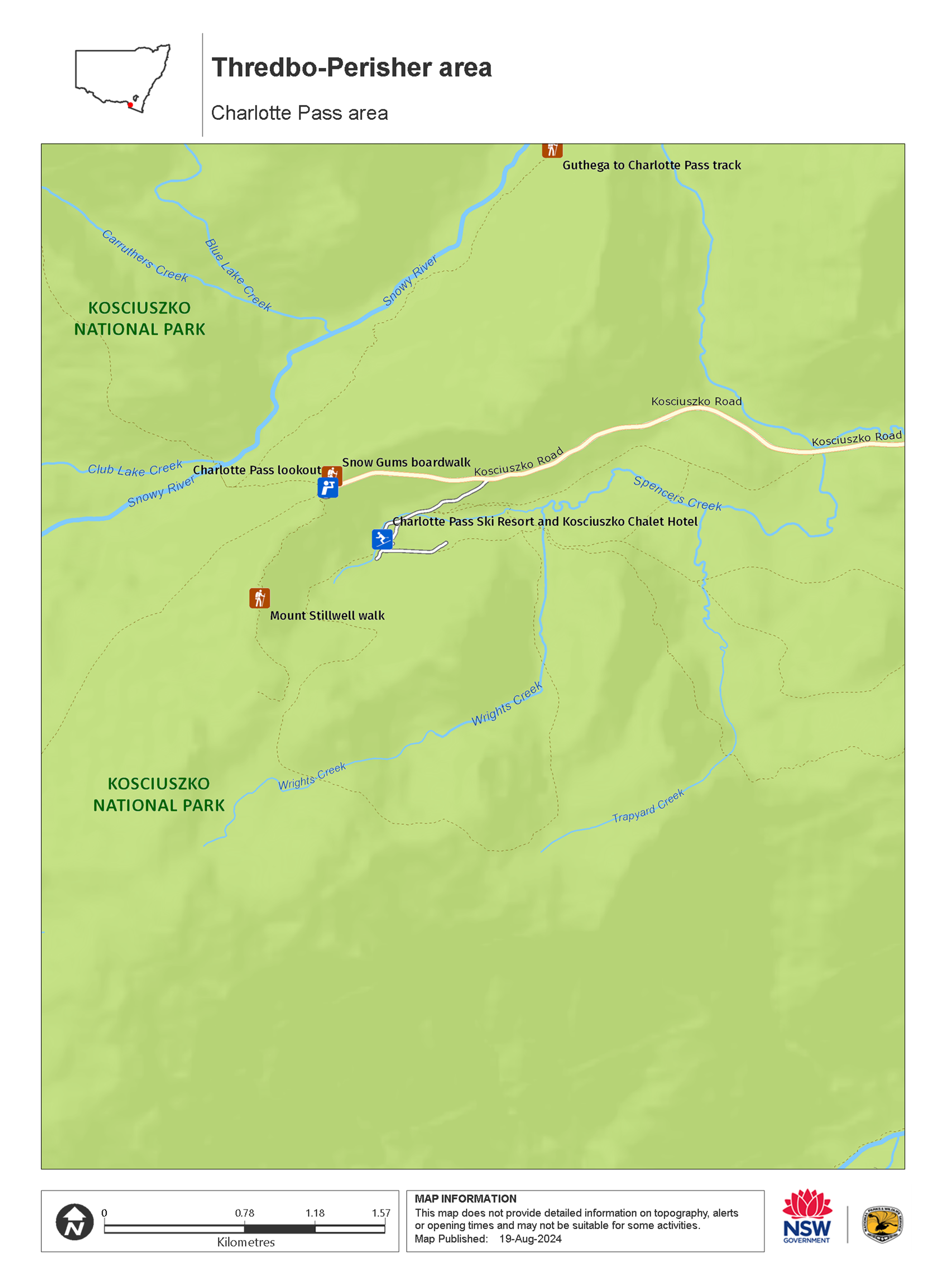
Map
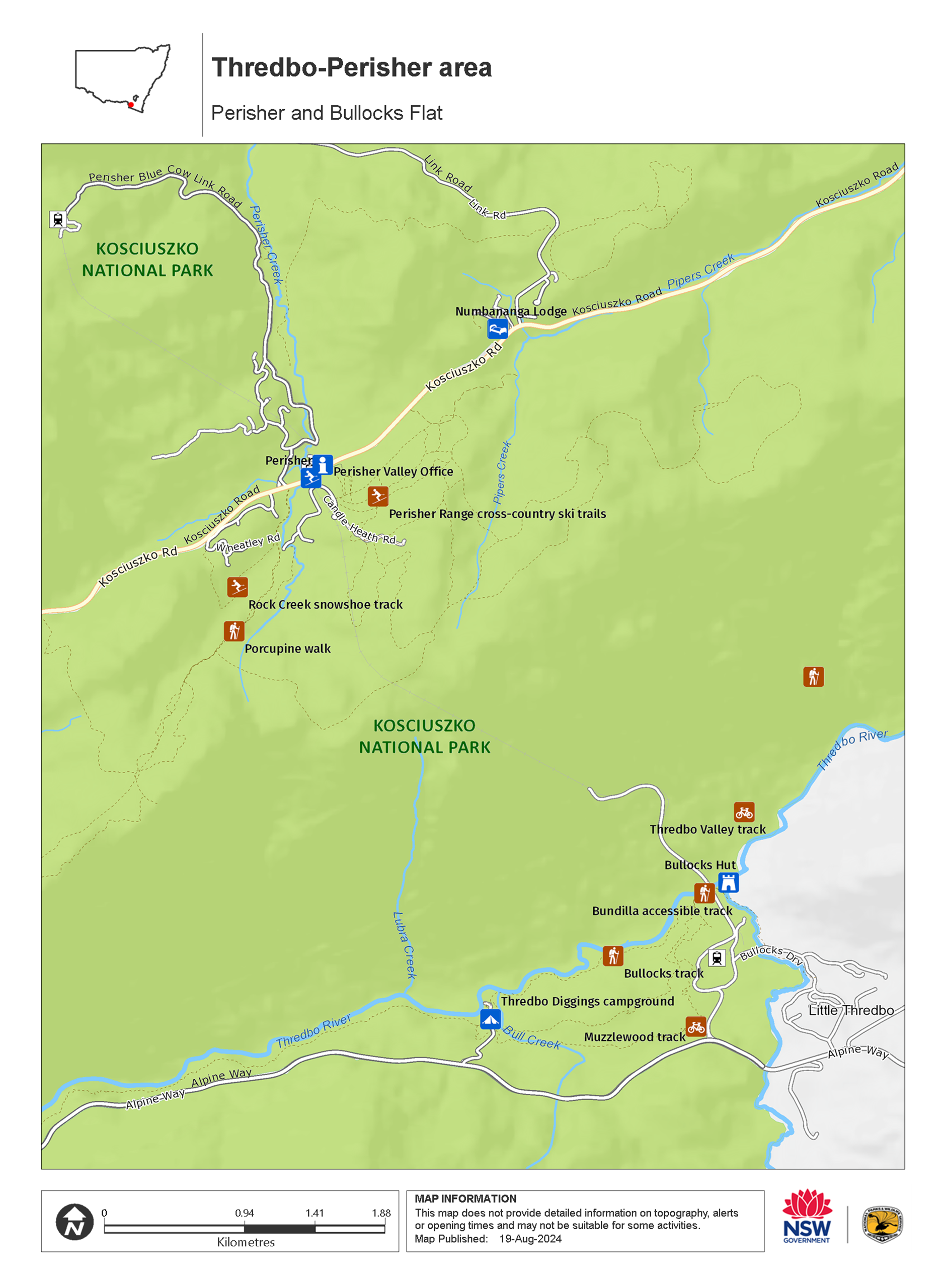
Map legend

Contact
- in Kosciuszko National Park in the Snowy Mountains region
- The Thredbo-Perisher area is open all year, but some roads and trails may close due to weather conditions or park management issues. Kosciuszko Road is closed between Perisher and Charlotte Pass in winter (June to October long weekends).
-
Park entry fees apply on Alpine Way and Kosciuszko Road
Winter (June to October long weekends): $29 per vehicle per day (24hrs from purchase); motorcycles $12; bus passengers $11.45 per adult, $3.60 per child per day. Find out more about the winter entry surcharge.
Rest of Year: $17 per vehicle per day (24hrs); motorcycles $7; bus passengers $6.60 per adult, $2.20 per child per day.
Passes: Day passes, multi-day passes and annual All Parks Pass available from NPWS visitor centres, local agents and operating vehicle entry stations. Single and Multi-Day passes are also available via the Park'nPay app. Short Breaks Pass: $68 for 5 days park entry at price of 4 days (not valid winter).
Read our Annual Pass FAQs for information.
Buy annual pass. -
-
Snowy Region Visitor Centre
02 6450 5600
Contact hours: 8.30am to 5pm daily. Closed Christmas Day. - 49 Kosciuszko Road, Jindabyne NSW 2627
-
Email: srvc@environment.nsw.gov.au
-
Snowy Region Visitor Centre
-
-
Perisher Valley office
02 6457 4444
Contact hours: Winter (June to October long weekends): Daily 8.30am to 4pm. Closed 12 to 1pm. Rest of year: Monday to Friday 8.30am to 4pm. Closed 12 to 1pm weekdays, all day Saturday and Sunday. - 9914 Kosciuszko Road, Perisher Valley NSW 2624
-
Email: perisher@environment.nsw.gov.au
-
Perisher Valley office
Visitor info
All the practical information you need to know about the Thredbo-Perisher area.
Maps and downloads
Visitor centre
-
Snowy Region Visitor Centre
49 Kosciuszko Road, Jindabyne NSW 2627 - 8.30am to 5pm daily. Closed Christmas Day.
- 02 6450 5600
Nearby towns
Jindabyne (8 km)
For those heading to the Snowy Mountains snowfields,
Cooma (65 km)
The Snowy Hydro Discovery Centre is a state-of-the-art visitor facility showcasing the story of the Snowy Mountains Hydro-Electric Scheme from the early construction days to the role the scheme plays today in the development of Australia.
Khancoban (70 km)
Plan ahead for your Snowy Mountains getaway and check out what's on in Khancoban. Extreme athletes love the Upper Murray Challenge that consists of a 38-km bike ride, a 26-km paddle and a 25-km run. The annual Khancoban TroutFest takes place every November at several area fishing holes.
Learn more
Thredbo-Perisher area is a special place. Here are just some of the reasons why:
Explore the rooftop of Australia
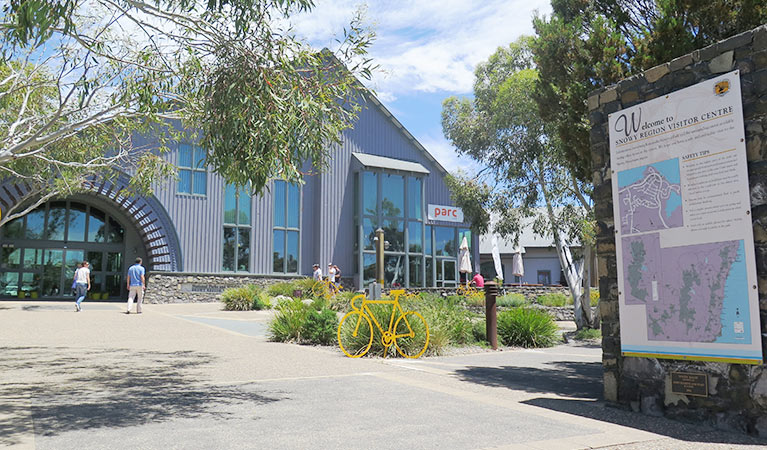
Skiers and snowboarders will be familiar with the fabulous snow sport facilities at Thredbo, Perisher and Charlotte Pass, but there are endless activities year-round. This area is a mecca for walkers and riders. Take in the spectacular 3600 views from Snow Gums boardwalk or Dead Horse Gap walk. A hike to Mount Kosciuszko is a must, while the awe-inspiring Main Range loop explores glacial lakes and the dramatic Western Fall. Take to 2 wheels on Thredbo Valley track, or get an adrenaline charge on the famous Cannonball Run. If you need some inspiration, stop by the Snowy Region Visitor Centre for tips on top experiences, guided tours, and where to stay. Kids can also learn more on a school excursion to the Kosciuszko Education Centre.
- Cross-country skiing activities in Perisher Feel the thrill of carving fresh tracks on the cross-country trails with Perisher X-Country. It’s a beautiful way to experience the alpine environment of Kosciuszko National Park.
- Kosciuszko laser biathlon sessions Whether it's summer or winter, give the thrilling sport of biathlon a try. With the help of instructors from NSW Biathlon, you'll learn to combine the skill of laser target shooting with skiing or roller skiing.
- Kosciuszko walk - Thredbo to Mount Kosciuszko This iconic day walk from Thredbo will have you conquering the summit of Mount Kosciuszko in a couple of hours. You'll quite literally be on a high as you soak in the epic views from Australia's highest point.
- Perisher Valley Office Perisher Valley Office, in the heart of Perisher Valley, is a handy last-minute stop for advice, maps, hiking essentials and important information before your alpine adventures in Kosciuszko National Park.
- Schlink Hut walking track Schlink Hut walking track is a high alpine hiking or mountain biking adventure near Perisher, visiting 3 historic huts in Kosciuszko National Park. Winter access is by snowshoe or cross-country skiing only.
Unique landscapes
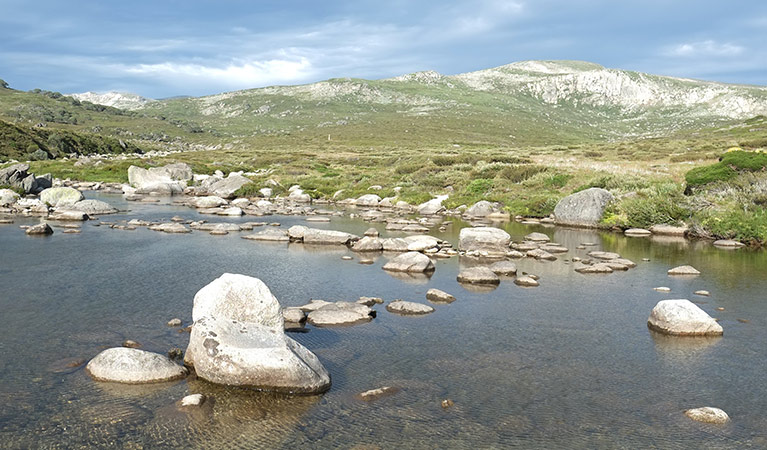
Kosciuszko National Park is a huge park containing Australia's only true alpine environment, the highest part of the Great Dividing Range, and all of NSW's ski resorts. Above the treeline of snow gums - the only trees to grow at this altitude - is a unique landscape of alpine herb fields, feldmark, bogs and tarns. A walk to the highest peak in mainland Australia, Mount Kosciuszko, is the perfect way to see this landscape. Walk from Thredbo or Charlotte Pass, and marvel at the huge granite tors and lakes carved out during Australia's last Ice Age, between 35,000 and 10,000 years ago.
- Cross-country mountain bike tours Challenge yourself on the brilliant trails of Kosciuszko National Park with K7 Adventures. From beginner to advanced level, there's a mountain bike experience waiting for you in the Snowy Mountains.
- Environmental scientist Primary students learn to think like an environmental scientist in this Stage 3 Science and Technology excursion. They'll investigate living things and their habitats in Kosciuszko National Park, and then plan and do their own simple scientific investigation.
- Going up the mountain Going up the mountain is a school excursion in Kosciuszko National Park for Stage 6 (Years 11-12) students focusing on Geography. Students will use field work to record and compare the geology, weather, native plants, animals, human use and sustainability of the montane, sub-alpine and alpine ecosystems.
- Guthega to Charlotte Pass walk Take in majestic views of Australia's highest peaks on the Guthega to Charlotte Pass walk, near Thredbo and Perisher. Follow the Snowy River and enjoy the fresh mountain air.
- Kosciuszko - a special place Kosciuszko a special place is a presentation for stage 6 (year 11-12) students focusing on Geography. This excursion highlights the unique natural and cultural features of Kosciuszko National Park, interaction of the four spheres, human impacts, sustainability and park management. Students have the opportunity to have their questions answered by an NPWS education officer.
Alpine plants and animals
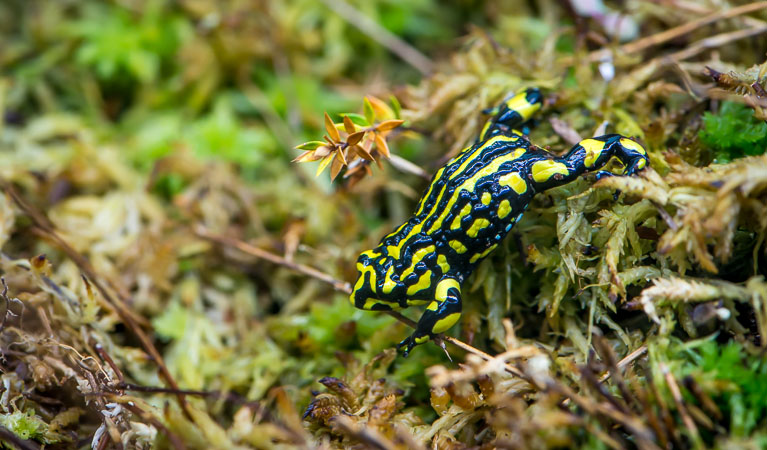
The park has over 200 species of alpine flowering plants and provides important habitat to nationally endangered species, such as southern corroboree frogs and broad-toothed rats. Ancient snow gums, twisted and stunted from the blasting effects of wind, snow and ice, mix with alpine ash and fragrant alpine mint bush. Above the treeline only heath, snow grass and the hardiest plants face the cold. Slow-growing mountain plum pine, some over 500 years-old, cling to boulders for warmth, providing shelter and food for threatened mountain pygmy-possums. Bogs of spongy sphagnum moss soak up the snow melt, to be released into alpine streams. From late spring to early summer, the heath is dotted with patches of wildflowers like alpine sunrays and snow daisies, yellow billy buttons, and the anemone buttercup, found only in Kosciuszko National Park.
- Biodiversity survey The biodiversity survey school excursion in Kosciuszko National Park for Stage 4 (Years 7-8) students focuses on Science. Investigate what 'biodiversity' means and use field equipment to assess the biodiversity of sample quadrats along a transect in the montane forest.
- Biodiversity survey The Biodiversity survey school excursion in Kosciuszko National Park for Stage 5 (Years 9-10) students focuses on science and fieldwork skills. Investigate what 'biodiversity' means and use field equipment to assess the biodiversity of sample quadrats along a transect in the montane forest.
- Charlotte Pass Village to Perisher Valley walk Charlotte Pass Village to Perisher Valley walk lets you explore the natural wonders of NSW high country. 12.9km one way and immersed in nature, it’s an ideal day walk in Thredbo-Perisher area.
- Environmental scientist Primary students learn to think like an environmental scientist in this Stage 3 Science and Technology excursion. They'll investigate living things and their habitats in Kosciuszko National Park, and then plan and do their own simple scientific investigation.
- Going up the mountain Going up the mountain is a school excursion in Kosciuszko National Park for Stage 6 (Years 11-12) students focusing on Geography. Students will use field work to record and compare the geology, weather, native plants, animals, human use and sustainability of the montane, sub-alpine and alpine ecosystems.
World-class wilderness
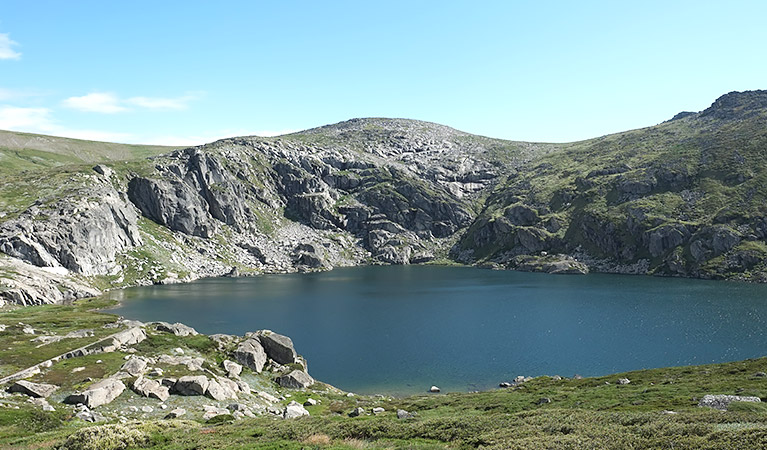
In recognition of Kosciuszko's unique value as a conservation area, it's been named a UNESCO Biosphere Reserve. More than half of the area of the park, over 350,000ha, has been declared wilderness, including the rugged Western Fall wilderness of the Main Range. It also contains Blue Lake, a rare cirque lake formed by the head of a glacier. Blue Lake is a listed Ramsar site, recognised for the role it plays in preserving rare and threatened species. The Australian Alps received National Heritage recognition in 2008, and were named one of Australia's National Landscapes.
- Schlink Hut walking track Schlink Hut walking track is a high alpine hiking or mountain biking adventure near Perisher, visiting 3 historic huts in Kosciuszko National Park. Winter access is by snowshoe or cross-country skiing only.
Plants and animals protected in this park
Animals
-

Bare-nosed wombat (Vombatus ursinus)
A large, squat marsupial, the Australian bare-nosed wombat is a burrowing mammal found in coastal forests and mountain ranges across NSW and Victoria. The only other remaining species of wombat in NSW, the endangered southern hairy-nosed wombat, was considered extinct until relatively recently.
-

Emu (Dromaius novaehollandiae)
The largest of Australian birds, the emu stands up to 2m high and is the second largest bird in the world, after the ostrich. Emus live in pairs or family groups. The male emu incubates and rears the young, which will stay with the adult emus for up to 2 years.
-

Platypus (Ornithorhynchus anatinus)
One of the most fascinating and unusual Australian animals, the duck-billed platypus, along with the echidna, are the only known monotremes, or egg-laying mammals, in existence. The platypus is generally found in permanent river systems and lakes in southern and eastern NSW and east and west of the Great Dividing Range.
-

Common brushtail possum (Trichosurus vulpecula)
One of the most widespread of Australian tree-dwelling marsupials, the common brushtail possum is found across most of NSW in woodlands, rainforests and urban areas. With strong claws, a prehensile tail and opposable digits, these native Australian animals are well-adapted for life amongst the trees.
-

Common ringtail possum (Pseudocheirus peregrinus)
Commonly found in forests, woodlands and leafy gardens across eastern NSW, the Australian ringtail possum is a tree-dwelling marsupial. With a powerful tail perfectly adapted to grasp objects, it forages in trees for eucalypt leaves, flowers and fruit.
-

Short-beaked echidna (Tachyglossus aculeatus)
One of only 2 egg-laying mammals in the world, the short-beaked echidna is one of the most widespread of Australian native animals. Covered in spines, or quills, they’re equipped with a keen sense of smell and a tube-like snout which they use to break apart termite mounds in search of ants.
-

Wedge-tailed eagle (Aquila audax)
With a wingspan of up to 2.5m, the wedge-tailed eagle is Australia’s largest bird of prey. These Australian animals are found in woodlands across NSW, and have the ability to soar to heights of over 2km. If you’re bird watching, look out for the distinctive diamond-shaped tail of the eagle.
-

Guthega skink (Liopholis guthega)
The endangered Guthega skink is the highest recorded skink in Australia. It lives only in alpine Kosciuszko National Park, and the Victorian Alps, above 1600m.
Plants
-

Billy buttons (Craspedia spp. )
Billy buttons are attractive Australian native plants that are widespread throughout eastern NSW in dry forest, grassland and alpine regions such as Kosciuszko National Park. The golden-yellow globe-shaped flowers are also known as woollyheads. Related to the daisy, billy buttons are an erect herb growing to a height of 50cm.
Environments in this area
School excursions (11)
- Going up the mountain, Stage 6 (Years 11-12), Geography
- Above the treeline, Stage 6 (Years 11-12), Geography
- Biodiversity survey, Stage 4 (Years 7-8), Science
- Kosciuszko - a special place, Stage 6 (Years 11-12), Geography
- Biodiversity survey, Stage 5 (Years 9-10), Science
- Kosciuszko - a special place, Stage 5 (Years 9-10), Geography
- Teddy bears' picnic, Early Stage 1 (Kindergarten), HSIE, Science and Technology
- Environmental scientist, Stage 3 (Years 5-6), Science and Technology
- Kosciuszko keepers and seekers, Stage 3 (Years 5-6), Geography
- Mountain pygmy-possum, Stage 6 (Years 11-12), Geography
- Going up the mountain, Stage 4 (Years 7-8), Geography
What we're doing
Thredbo-Perisher area has management strategies in place to protect and conserve the values of this park. View the detailed park and fire management documents. Here is just some of the work we’re doing to conserve these values:
Understanding landscapes and geology
Geo conservation efforts play an important role in protecting the delicate ecosystems of Kosciuszko National Park's fragile alpine landscapes. Rehabilitation and maintenance works to limit the impact of erosion and degradation, and monitoring the effects of climate change and visitation, are ongoing.
Preserving biodiversity
Kosciuszko National Park plays an important role in conserving NSW's biodiversity by protecting its vulnerable, threatened and endangered species. Conservation activities, such as the southern corroboree frog and mountain pygmy-possum conservation programs, are carried out in the Thredbo-Perisher area. These activities include monitoring species' habitats, distribution and population.
Managing weeds, pest animals and other threats
Pests and weeds have a significant impact on the ecosystems and habitats within the Thredbo-Perisher area of Kosciuszko National Park. Reduction of pest species, such as deer and goats, is an important part of the work NSW National Parks and Wildlife Service (NPWS) does to protect the integrity of wilderness areas, water, and important biodiversity.
Historic heritage in our parks and reserves
The historic heritage of Kosciuszko National Park is preserved through a variety of NPWS programs that embrace its past. Heritage revitalisation and adaptive reuse projects, such as Bullocks Hut, are ongoing in this area of the park.
Developing visitor facilities and experiences
NPWS is committed to developing facilities for the enjoyment and safety of visitors in Kosciuszko National Park. Visitor feedback and environmental sustainability are key considerations in park maintenance, and upgrades are ongoing. Campgrounds, picnic areas, trails and lookouts are continually maintained and upgraded, and NPWS regularly reviews the park’s recreational opportunities, identifying areas for improvement or addition. Hazard assessments are also ongoing.
Kosciuszko National Park has achieved Australia’s first Ecotourism Destination Certification, through Ecotourism Australia, recognising best practice sustainable tourism and visitation in protected areas.
Managing fire
NSW is one of the most bushfire prone areas in the world due to our climate, weather systems, vegetation and the rugged terrain. NPWS is committed to minimising the likelihood and impact of bushfires via a strategic program of fire research, fire planning, hazard reduction, highly trained rapid response firefighting crews and community alerts.

